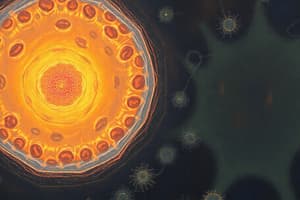Podcast
Questions and Answers
What are prokaryotes?
What are prokaryotes?
No nucleus or membrane-bound organelles.
How does DNA exist in prokaryotes?
How does DNA exist in prokaryotes?
- As a single circular strand (correct)
- In multiple segments
- As multiple linear strands
- In a double helix structure
Where is the DNA located in prokaryotes?
Where is the DNA located in prokaryotes?
In the nucleoid.
Prokaryotes have membrane-bound organelles.
Prokaryotes have membrane-bound organelles.
What is a characteristic of prokaryotic cells?
What is a characteristic of prokaryotic cells?
Prokaryotic ribosomes are larger than eukaryotic ribosomes.
Prokaryotic ribosomes are larger than eukaryotic ribosomes.
What is the method of cell division in prokaryotes called?
What is the method of cell division in prokaryotes called?
Eukaryotic cells have which of the following?
Eukaryotic cells have which of the following?
What is the size range of eukaryotic cells?
What is the size range of eukaryotic cells?
In eukaryotes, how is DNA structured?
In eukaryotes, how is DNA structured?
What is the function of the nuclear envelope in eukaryotes?
What is the function of the nuclear envelope in eukaryotes?
Eukaryotic motility structures have microtubules.
Eukaryotic motility structures have microtubules.
What is the composition of the eukaryotic plasma membrane?
What is the composition of the eukaryotic plasma membrane?
Which of the following are similarities between prokaryotic and eukaryotic cells?
Which of the following are similarities between prokaryotic and eukaryotic cells?
Eukaryotic cell walls are made of peptidoglycan.
Eukaryotic cell walls are made of peptidoglycan.
Flashcards are hidden until you start studying
Study Notes
Prokaryotes
- Lack a nucleus and membrane-bound organelles, distinguishing them from eukaryotic cells.
- DNA is a single, circular strand with no ends, located in a region called the nucleoid, which is not surrounded by a protective membrane.
- No membrane-wrapped organelles such as mitochondria or Golgi apparatus.
- Primarily unicellular, smaller (0.2-2.0 µm in diameter), and less complex than eukaryotic cells.
- Contain smaller ribosomes that are not membrane-bound.
- Flagella and cilia are present but lack microtubule structure.
- Possess a rigid cell wall made of chemically complex peptidoglycans, providing protection and maintaining shape.
- Reproduce through binary fission, resulting in two identical cells quickly, leading to lower genetic variation.
Eukaryotes
- Feature cells with a membrane-bound nucleus and enclosed organelles, including mitochondria and the endoplasmic reticulum.
- Predominantly multicellular, larger (10-100 µm), and more complex than prokaryotes.
- DNA exists in multiple linear strands, organized within the nucleus.
- Enclosed by a double membrane nuclear envelope, which is continuous with the endoplasmic reticulum, regulating molecular traffic.
- Flagella and cilia contain microtubules, differing in size and function compared to prokaryotic structures.
- Plasma membrane is a phospholipid bilayer with embedded proteins and cholesterol, contributing to its fluidity.
Similarities Between Prokaryotic and Eukaryotic Cells
- Both contain a plasma membrane to maintain cellular integrity.
- Both have genetic material (DNA/RNA), although prokaryotic DNA is circular and eukaryotic DNA is linear.
- Ribosomes are present in both cell types; however, prokaryotic ribosomes are smaller and not membrane-bound.
- Both may have cell walls, although prokaryotic walls are made of peptidoglycan while eukaryotic walls consist of various polysaccharides, such as chitin in fungi and cellulose in plants.
- Contain organelles like plastids in plants for photosynthesis, but these are not found in prokaryotes.
- Both may have flagella for movement, albeit constructed differently.
Studying That Suits You
Use AI to generate personalized quizzes and flashcards to suit your learning preferences.




